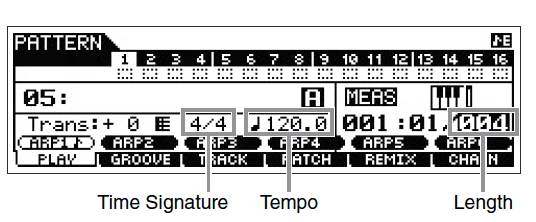Any time you record something in PATTERN mode, the MO-XF sequencer will place that information on a track in an entity called a “Phrase”. So a Phrase is a group of MIDI events that can then be moved, recalled and edited as a unit. For example, say you record a drum kit to Track 1 – you use a Kick, snare, high hat closed, high hat open, and a crash cymbal. Say you record for 008 measures and then stop. The MO-XF sequencer will automatically number this recording and archive it as PHRASE 001. You can make a total of 256 individual recordings like this in a PATTERN. They can be drums, bass, guitars, etc.; the instrument does not really matter. Any time you record in a PATTERN the data is placed in a PHRASE and given the lowest available number designation between 001 and 256. Why 256? Because there are 16 tracks in the sequencer and there are 16 Sections in Pattern mode – 16×16 = 256 possible Phrases. Normally, this is many more than you will need.
You can additionally name each phrase if you wish. Most people find, however, that the number that is assigned is sufficient. But if you are one of those people who like to keep things strictly organized, you can name each Phrase with a [JOB] > [F4] PHRASE > Job 09: PHRASE NAME.
A PHRASE can be activated in any Section. Say you know that the basic groove you just recorded in SECTION “A” (your first verse), will be used again in the composition for the third verse (SECTION ‘C’)… different musical parts on top but the same drum groove. You do not have to COPY it, simply go to SECTION ‘C’ and activate PHRASE 001. Phrases can be recalled simply by selecting them – very convenient. A Phrase contains all the MIDI data that you generated while the track was in record. It is not sound… it is the MIDI data. It is not the VOICE you selected, it is the MIDI data. It is that MIDI data organized in a reusable, numbered package. It has a Phrase LENGTH shown next to the PHRASE number.
From the main PATTERN Play screen:
• Press [F4] PATCH

The first three TRACKs of SECTION B three Phrases, numbered 008, 009 and 010, are ‘patched’ to the grid. The Length of each is shown to the right of the Phrase Number and is an indication of how many measures you have recorded before these phrases begin to loop (M004 = 4 measures). The Phrases are numbered in the order that you record them. The Phrase Length is determined by a parameter setting made prior to entering record. In order for PATTERN phrases to loop, you must, quite naturally, set a phrase length before starting. This is found on the main PATTERN screen:

The Phrase Length parameter, the Time Signature and the Tempo are the mathematics that the technology uses to deal intelligently with our music. As musicians we do not use clock time (minutes and seconds) to subdivide our compositions, rather we use Measures and Beats. Once you define this framework (4/4 Time and 004 Measures) your recorded phrases will maintain that form, such that at the end of the four measures the phrase will seamlessly repeat from the top (whether or not the sound is seamless, will depend on your performance, but the technology will return the exact length every time at the current tempo). Each phrase is a separate entity. You cannot simply change the number of measures you have recorded (without executing an edit job). Part of what is recorded into the PATTERN’s Phrase data is the number of measures that were set at the time you recorded it.
While in PATTERN mode you can manually control how many times, for example, this SECTION “B” repeats. You can change to another Section using the front panel buttons designated as SECTION CHANGE (A-H and I-P). The change from one Section to another can be set to happen at the top of the next measure (this way a phrase can be allowed to complete before the Section change occurs), or you can have the MO-XF change to the next Section at the nearest half note, quarter note, eighth note or sixteenth note.
This is set by a (PtnQuantize) PATTERN QUANTIZE parameter.
• Press [UTILITY]
• Press [F2] SEQ
• Press [SF3] OTHER
• PtnQuantize or Pattern Quantize has to do with correcting to the nearest musical value the PATTERN SECTION selection.
Required: PATTERN SECTION button must be lit in order for buttons [1]-[16] to take on the role of SECTION A-P selection switches.
This may be a new gesture for you – but by pressing the SECTION button in the measure just prior to the measure you want it to change is something that you can quickly get used to. You can press that button anywhere during the preceding measure, the change faithfully takes place automatically at the appropriate time – you do not have to hit it with the precision of playing a musical note. The screen will briefly show a letter “N” to indicate your NEXT selection. The letter will disappear at the top of that next measure and the measure will transition on cue.
Nested Loops
Phrase Length is shown on the [F4] PATCH screen; however, SECTION Length is determined by how many times you let the Section repeat. Please also note that Phrases can be at various lengths. You could have a 1 Measure Kick drum and a 4 Measure Snare with an 8 measure Hihat Phrase all playing along side each other. Each will repeat according to its Phrase Length. The KICK Phrase will play 8 times for each Hihat Phrase.


